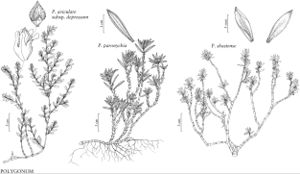Polygonum paronychia
Linnaea 3: 51. 1828.
Shrubs or subshrubs. Stems prostrate or ascending, brown, branched, rooting at nodes, not wiry, 10–100 cm, glabrous, covered with remains of lacerate, hyaline ocreae. Leaves crowded at branch tips, articulated to ocreae, basal leaves caducous or persistent, distal leaves not reduced in size; ocrea 15–20 mm, glabrous, proximal part cylindric to funnelform, distal part silvery, entire or slightly lacerate, disintegrating into persistent white-gray curly fibers; petiole 0–0.5 mm; blade 1-veined, without pleats, linear to oblanceolate, (5–) 10–20 (–33) × 3–8 mm, coriaceous, margins revolute, smooth, apex acute or mucronate. Inflorescences axillary; cymes crowded in distal axils, 2–5-flowered. Pedicels enclosed in ocreae, erect to spreading, 2–5 mm. Flowers semi-open or open; perianth (4.5–) 6–10 mm; tube 22–48% of perianth length; tepals partially overlapping, uniformly pink or white, reddish-brown when dried, petaloid, oblong-ovate to ± lanceolate, apex rounded; midveins pinnately branched; stamens 8. Achenes enclosed in or slightly exserted from perianth, black, ovate, 4–5 mm, faces subequal, shiny, smooth.
Phenology: Flowering Mar–Sep.
Habitat: Coastal sands, scrub along coast
Elevation: 0-50 m
Distribution

B.C., Calif., Oreg., Wash.
Discussion
Polygonum paronychia may be cultivated in rock gardens in open sites with sandy soil.
Selected References
None.
Lower Taxa
"/2" is not declared as a valid unit of measurement for this property.
